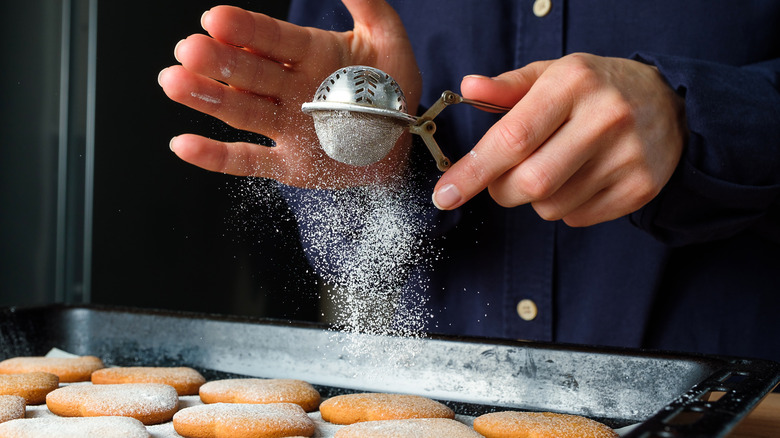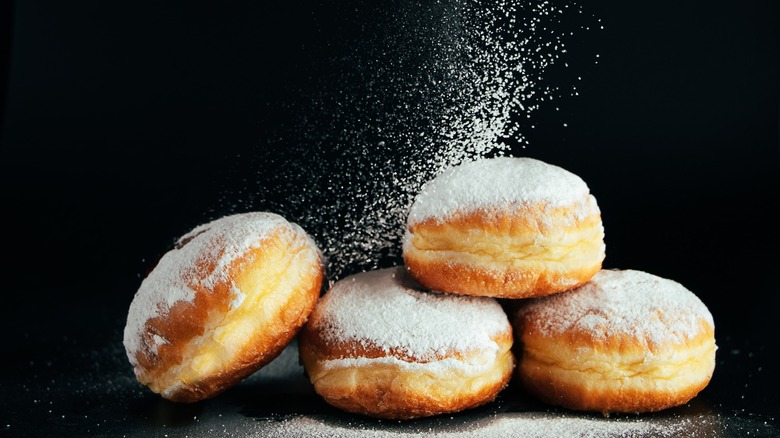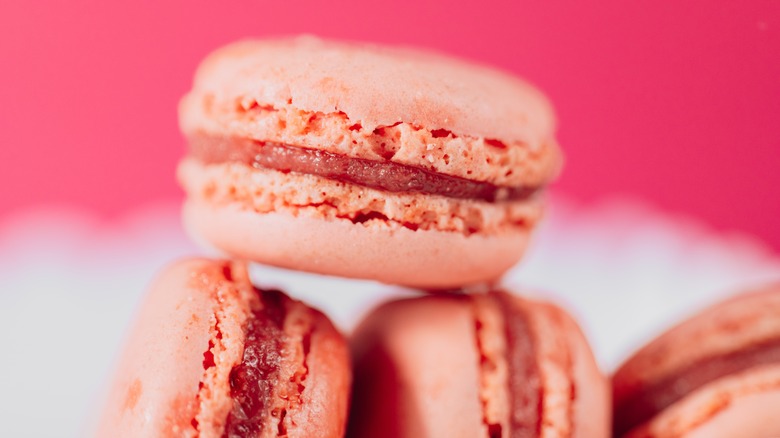The 3 Common Types Of Confectioners' Sugar, Explained
Aside from adding sweetness, sugar helps baked goods retain their moisture, feeds yeast, stabilizes egg whites, prevents the gluten bonds in flour from over-toughening during the baking process, enhances other flavors (like salt), and creates craveable golden-brown caramelization under heat. A sugar by any name would still taste as sweet, or whatever Shakespeare said in that line from "Romeo and Juliet." But all sugars are not created equal.
When bakers aim for melt-in-your-mouth smoothness and a light, airy texture in their treats, confectioners' sugar is the move. It might seem interchangeable with any other sugar (high maintenance, much?), but the type of sugar utilized in a sweet treat can make a big difference in its final turnout. Even within the confectionery sugar class, there are further divisions based on grain size to help bakers select the right tool for the job.
Confectioners' sugar is ultra-finely ground granulated sugar, aka table sugar, the stuff you might stir into your coffee. In Canada and the U.K., it goes by another name: icing sugar, and it's also referred to as "XXX" sugar, a now-outdated name you might spy in vintage American cookbooks. In descending order of grain size, these classes of refined white cane sugar include sparkling, sanding, granulated, fine, extra fine, superfine, ultrafine, 6x powdered, 10x powdered, and 12x powdered.
6x confectioners' sugar is best for dusting
Unlike granulated sugar, confectioners' sugar contains 95%-97% sucrose due to the addition of 3%-5% cornstarch, an additive anti-clumping agent to ensure a consistently snow-like, powdery texture. In fact, confectioners' sugar being colloquially called "powdered sugar" is disputed, as some sources substantiate that true powdered sugar does not include any cornstarch. The addition of the cornstarch, although quantitatively small, is responsible for the slight floury taste of confectioners' sugar. Some brands, especially organic options, use different proprietary blends of tapioca starch or potato starch instead of cornstarch.
The crystal grain size of confectioners' sugar is less than 0.1 mm. In the case of 6x sugar, the "6" refers to the number of times the sugar has been processed and milled. Larger grains like 6x are better fits for dusting powders or sweet finishes that won't totally dissolve and disappear too quickly. 6x is often used as a garnish or for other decorative purposes and can be spied piled atop powdered donuts, brownies, and crinkle cookies. For maximum evenness and lightness, it's dusted with a fine mesh sieve.
10x confectioners' sugar is best for frosting and icing
The most common type of confectioners' sugar is 10x, which totally gets the job done for most home baking needs. If you're a commercial baker or looking for a professional-quality sugar for a specific job, you'll likely need to hit up a restaurant supply store or order from a specialty online retailer to track down 6x or 12x. Just like 6x, 10x confectioners' sugar is also common for dusting, but it makes a uniquely fast and effective icing or frosting when combined with a liquid component, like cream, liqueur, amaretto, or a splash of full-fat oat milk for a lush vegan spread.
Granulated sugar used in the same way will yield gritty, unspreadable messes. With the addition of more liquid, it can be used to make a thinner icing for topping cinnamon rolls or muffins, or it can be used to make a knockout buttercream frosting. If you absolutely need a substitute in a pinch, use 1 cup of granulated sugar for every 1¾ cups of powdered sugar. Or better yet, slam 1 cup of that granulated sugar along with 1 tablespoon of cornstarch into a blender or food processor and pulse it into a finely-ground confectioners' sugar made at home.
12x confectioners' sugar is best for when you need a fast-dissolving sweetener
12x, the finest grade of all, can be a tad tough to handle considering it's extra prone to caking, clumping, and bursting into a cloud of uncontrollable dust (try not to sneeze around a bag of 12x!). But thanks to its superfine grain, this smallest grade of confectioners' sugar dissolves very easily, making it a natural fit for use in baking more delicate treats, making dense fondant, and achieving crisp skirts on French macarons. It might seem like a nuanced difference, but considering the x value refers to the number of times the sugar has been milled and processed, 12x confectioners' sugar is twice as fine as 6x.
Thinner grains like 10x and 12x are both good fits for making smooth icings, but 12x is a better fit for making homemade whipped cream, as ultra-fine confectioners' sugar will dissolve more easily into the chilled cream. It's also the secret weapon for homemade chocolate milk with a velvet-smooth consistency and great for making melt-in-your-mouth candies and fudge.



